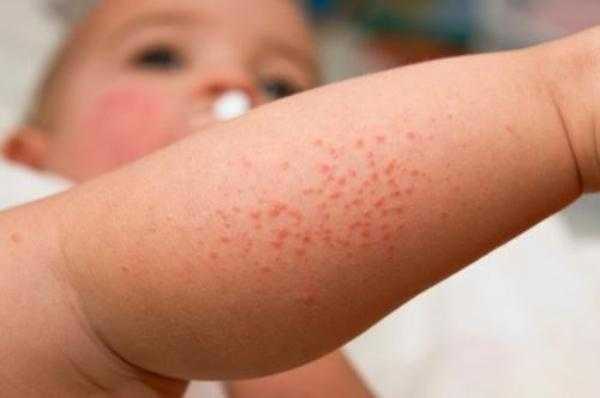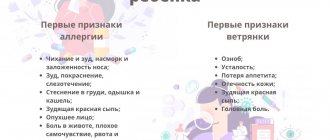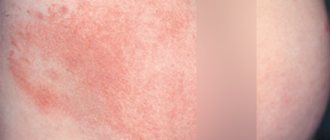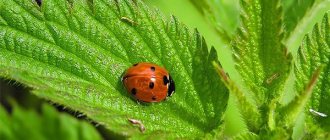Miliaria - causes and features
Children in the first year of life are most susceptible to prickly heat. This disease in infants is caused by immaturity of the sweat glands.
Most often, prickly heat appears on poorly ventilated areas of the skin, which include skin folds:
Photo by Dr Orlena Kerek
- axillary,
- inguinal,
- intergluteal,
- folds on the neck,
- behind the ears,
- under the mammary glands,
- between your fingers.
The disease can also occur on the bends of the knees and elbows, and on areas of the skin that adhere tightly to synthetic fabrics.
Miliaria or miliaria is a skin irritation that causes increased sweating and at the same time slow evaporation of sweat.
There are several types of the disease:
| View | Characteristic |
| Crystal prickly heat | It appears as white or pearlescent bubbles with a diameter of 1-2 mm. In cases where there are too many rashes, the bubbles begin to merge with each other and therefore it seems that the rashes are large. During friction with the fabric and surface, the bubbles burst and the baby's skin begins to peel off. This type of miliaria in an infant often occurs on the upper half of the body, face and neck. |
| Miliaria rubra | It looks like uniform nodules or small bubbles in the center of a reddened spot. This type of rash causes itching and pain when touched. Discomfort increases if air humidity rises. |
| Miliaria profuse | This is the name for bubbles up to 3 mm in size, which match the color of the skin. This type of heat rash appears on the arms, legs and torso and goes away within a few hours. |
Crystalline miliaria usually occurs in infants. It does not require any special treatment, does not cause discomfort to the baby and goes away on its own in a couple of days.
Treatment of red and deep miliaria should begin only after the causes of its appearance have been eliminated.
Miliaria is sometimes confused with eczema. But unlike prickly heat, eczema is characterized by dry, red, crusty patches that tend to get larger. This disease occurs in 20% of babies aged 3-4 months.
Miliaria in infants and adults: photo
Factors that provoke prickly heat include:
- Increased body temperature during illness;
- Excessive use of creams that clog skin pores;
- Long exposure to the sun;
- Heat and high humidity outside or at home;
- Excess weight and a large number of skin folds.
In addition, prickly heat occurs more often in people with pathologies of the endocrine system and diseases of the nervous system. Irritation may also appear after physical work or illness with accompanying high fever and sweating.
It's important to understand
Miliaria is not an infectious disease, it is not accompanied by a change in a person’s condition and is not transmitted by contact
Useful video about prickly heat from the Union of Pediatricians of Russia:
Miliaria in children
Miliaria (miliaria) develops in children in conditions of high humidity and ambient temperature due to the insufficiency of the thermoregulation system and the functioning of the sebaceous glands.
Factors predisposing to the development of heat rash in newborns:
- imperfection of thermoregulation;
- thinness and vulnerability of the epidermis;
- reduced immune defense of the baby's skin;
- well-developed network of skin blood vessels;
- narrowed ducts of the sebaceous glands;
- female gender of the child;
- non-compliance with hygienic rules for caring for infants;
- excessively wrapping children.
There are 3 forms of miliaria:
The prickly heat rash is represented by blisters or nodules (in the red form), the color is pale pink. More often it appears in places of increased overheating of the skin under clothing, in folds. The rashes do not flake or itch. Miliaria quickly goes away even without the use of medicinal ointments, subject to proper hygiene.
Causes and symptoms of allergies
Manifestation of allergies on the back of an infant
The cause of allergies is the entry of allergens (antigens) into the body. This manifests itself primarily as rashes on the skin.
Breastfed newborns experience mainly food allergies, which can sometimes be confused with prickly heat.
Scaly spots or pimples appear on the child’s thighs, buttocks, head, armpits, and on the folds of the arms and legs. Initially, the allergic rash is localized in several different areas, and after that it can merge into one large one.
In addition to food allergies, skin manifestations are usually accompanied by allergies to medications and sweat.
Allergic reaction to sweat
Miliaria can also easily be confused with a sweat allergy. But these two diseases actually have significant differences. An allergic reaction to sweat occurs in any part of the body and occupies a large area, unlike prickly heat. This type of allergy goes away on its own within a couple of hours.
An allergic reaction is expressed in adults by the following symptoms:
- After excessive sweating, light pink blisters appear on the skin (sometimes they are filled with liquid).
- The rash is accompanied by itching of varying strength.
- Allergies appear in areas of greatest sweating (armpits, neck, natural skin folds.
- Sometimes, in addition to rashes, allergies can be expressed by nausea, vomiting, increased salivation, and stool disorders.
Allergies in children and adults: photos
Let's sum it up
Brief information on the article that will help parents properly help their baby when rashes appear.
- A baby with rashes should be shown to a specialist.
- Miliaria (miliaria) develops in children in conditions of high humidity and ambient temperature due to the insufficiency of the thermoregulation system and the functioning of the sebaceous glands.
- The prickly heat rash is represented by blisters or nodules (in the red form), the color is pale pink.
- Risk factors for the appearance of allergic rashes include the recent introduction of new products, the use of a different washing powder, new care cosmetics, and taking medications.
- The child's skin should be treated with moisturizers on the advice of a doctor. It is often necessary to apply up to 4 - 6 applications during the day.
- If the skin becomes wet, lotions are used for treatment; if it peels, fatty ointments are used.
Thus, in this article we examined the main prerequisites for the appearance of prickly heat in a child, the characteristics of the elements of the rash in miliaria and allergic dermatoses. Issues on proper skin care if you are prone to rashes were also covered.
How to distinguish skin allergies from prickly heat
With a careful analysis of the rashes, as well as the causes of their occurrence, differences can be found. This is very important, since the treatment of prickly heat involves mainly hygienic measures, and allergies require complex treatment (antihistamines, avoiding contact with the allergen, adjusting the diet).
note
In addition to allergies and prickly heat, skin rashes can be caused by other factors.
Check out the article: Newborn acne or allergies?
To exclude allergies in newborns, you need to know the main factors that can trigger them.
- Introduction of new products into complementary foods.
- Washing baby clothes with new detergent.
- Using clothing made from fabric that is new to the baby.
- Mother's consumption of new foods during breastfeeding.
In the table below you will find the main differences between miliaria rashes and allergic reactions, which will answer the question of how to distinguish prickly heat from allergies.
| Allergy | Prickly heat |
| The rash appears on the face, abdomen, limbs (particularly on the folds), buttocks | There is no rash in the face area |
| Allergic rash does not depend on overheating of the child | As a rule, it appears at high indoor temperatures in places that sweat a lot (armpits, neck, buttocks, back, bends of limbs) |
| The rashes are bright red in color and look like bubbles with liquid inside. The rash merges into large spots, and upon healing they become rough to the touch. | The rash is small and pink. The skin does not peel off. |
| The rashes go away if you avoid contact with the allergen and use antiallergic drugs prescribed by your doctor. | If the areas of the rash are dried, the rash goes away within about a day. If you bathe your child more often, wash your child regularly, and change diapers more often, heat rash will disappear without treatment. |
How to distinguish heat rash from allergies around the eyes?
Miliaria does not appear on the face, therefore, if we are talking about a rash around the eyes, it is an allergic reaction.
Are red cheeks a heat rash or an allergy?
As a rule, prickly heat does not appear on the face. The appearance of a rash on the cheeks most likely indicates allergic dermatitis. The rash may alternate with the appearance of red, rough spots on the face
Appearance
You can distinguish diaper rash from an allergy by its appearance.
The first is manifested by reddish spots on the skin, which can develop into ulcers, pustules or cracks.
The redness is initially localized in one place, spreading evenly over the entire area of contact with the irritant, and takes on a bright red or purple color. The disease manifests itself on the outside not only as reddish spots, but also as swelling.
Specialists at the Capital Doctor clinic clarify that allergies are characterized by rashes in the form of spots, pimples or dots.

Its contact form is often found, which arises for the following reasons:
- poor quality for clothing. They can cause an allergic rash and redness on the body, especially in places where synthetics come into contact with the skin;
- swimming in chlorinated water;
- dyes that are used for toys and clothing;
- low-quality toys made of toxic plastic;
- household chemicals, specifically washing powders with aromatic additives and chemical neutralizers.
Return to contents
Treatment methods for prickly heat
First of all, treatment of the skin of newborns involves disinfection and cleansing of the skin. This is necessary so that it does not start to become inflamed.
Most often, the treatment of prickly heat does not require special measures; it is enough to keep the skin clean
One of the old tips for getting rid of miliaria is bathing in a solution of potassium permanganate . A weak solution of potassium permanganate is added to the bathing bath. The water should turn light pink.
Herbal medicine is also considered one of the treatment options . You can add chamomile decoction to the bath before bathing. This herb is known for its bactericidal properties and helps get rid of prickly heat in children. A tablespoon of chamomile is brewed with a glass of boiling water, left for an hour and poured into the bath. This method of treatment can be either quick or long-term, depending on how severely the disease has developed.
Also, sometimes prickly heat in children is treated with soda . To do this, dilute a teaspoon of soda in a glass of boiled warm water, moisten a napkin in the solution and wipe problem areas of the skin.
Of course, it is very difficult to cure this disease without eliminating its cause. In the children's room it is necessary to regulate the temperature and humidity. Children's cosmetics should be changed to more delicate and non-greasy ones.
Don’t forget about air and sun baths for your baby, because his skin should be ventilated and breathe. The famous doctor Komarovsky gives a lot of advice on this matter.
Is prickly heat treated with anti-allergenic drugs?
Anti-allergenic drugs in the treatment of prickly heat help eliminate skin itching. For example, fenistil gel helps to cope with prickly heat (it should be applied to the areas affected by the rash in a thin layer. The frequency of use is from two to four times a day). Desitin or Bepanten also help equally well with both prickly heat and allergies. The frequency of applying ointments to the affected areas is once or twice a day.
Popular remedies for prickly heat
Today there are many remedies that help get rid of this disease.
- Bepanten helps restore damaged skin and moisturize it. This is one of the most effective means.
- Zinc ointment perfectly dries the skin, which helps eliminate rashes.
- Sudocrem is known for its antibacterial and drying properties.
- No less famous is Fenistil gel , which helps eliminate redness on the skin. In addition, this remedy can eliminate dermatitis.
Fenistil gel for prickly heat and allergies
Fenistil gel is an antihistamine that is good at relieving skin itching both during prickly heat and allergic reactions. The only contraindication to the use of this product is individual intolerance to the substances contained in it. Before using the drug, despite its safety, you should consult your pediatrician.
Apply the product only to the areas of skin affected by the rash, 2-4 times a day. It is necessary to use the ointment until the symptoms of prickly heat or allergies completely disappear. If there is no improvement, then stop using the drug and try to find another treatment.
Is it possible to use tar soap for prickly heat and allergies?
The therapeutic effect of tar soap (10% birch tar, 90% ordinary soap) lies in its antiseptic and drying properties. The value of this soap is also that it does not contain chemical fragrances (this makes tar soap well suited for sensitive skin).
That is why it helps well with prickly heat (problem areas are washed with soap. And if you have allergies, you should use this type of soap with caution and only after consulting a doctor
Tips for caring for the skin of infants prone to prickly heat and allergic rashes
If your children often suffer from rashes, these recommendations will help avoid exacerbations.
1. Bathe your baby daily.
Remember that a warm bath is better than a shower. The water temperature should be kept within 37 °C.
It is recommended to stand or boil water for bathing. You can add soft detergents from the Mustella, Topicrem, and Atoderm lines to it.
2. The child’s skin should be treated with moisturizers on the advice of a doctor. It is often necessary to apply up to 4 - 6 applications during the day. The products “Lipikar”, “Mustella StelAtopia”, “Realba”, “Atoderm” have proven themselves well.
3. The baby’s clothes should be cotton; do not use underwear made from synthetic fabrics.
- the baby's skin must breathe;
- It is forbidden to wrap up a child.
4. If you notice that the baby is sweating, then change his clothes.
5. Do not use detergents containing ammonia to clean your apartment. It is better to use special products for people with allergies.
6. Maintain the required level of humidity and temperature.
- use a humidifier;
- recommended air temperature in the apartment is 20 - 22 °C;
- carry out daily wet cleaning;
- use air purifiers.
Diagnosing prickly heat in infants
Symptoms of the disease appear almost identically in all children.
Externally, prickly heat looks like spots or blisters filled with clear liquid against the background of reddened skin. This is irritation of the child's skin when sweating is more intense than evaporation. At the same time, you will probably notice that the child behaves restlessly, is capricious, sleeps poorly and constantly spins, which is quite justified, because prickly heat causes a burning sensation of the skin. This serves as a kind of signal from the baby’s body for you to carefully examine him. By the way, the rash rarely appears on the face. This will help you to some extent distinguish heat rash from allergies in an infant.
Types of disease
Based on the type of rash, prickly heat is divided into:
Red miliaria looks like blisters against the background of redness of the skin. The blisters do not merge with each other and cause itching and pain when touched.
In infants, the second type of prickly heat most often manifests itself - crystalline. These are white or pearlescent blisters that are slightly larger in diameter than prickly heat rashes. Elements of the rash can merge with each other, they are easily damaged and the skin in this area peels off.
Miliaria profunda is characterized by flesh-colored rashes measuring 1-3 mm. They can appear and disappear on their own.










